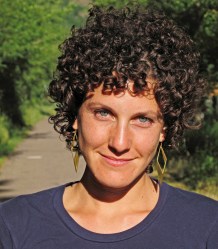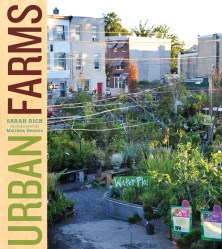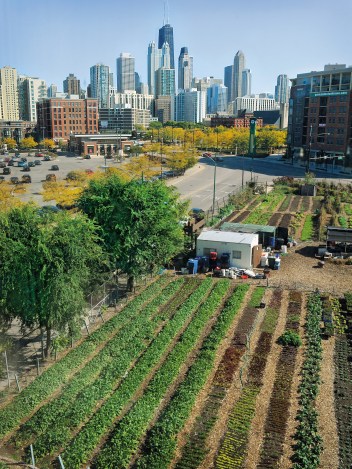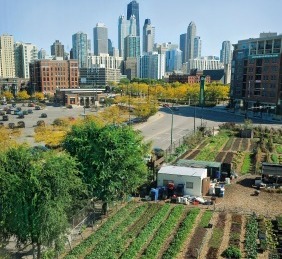
Sarah Rich, author of Urban Farms.
A former editor at Dwell and co-founder of the Foodprint Project, Sarah Rich thinks and writes about food as a key component of today’s urban landscape. So when she and photographer Matthew Benson traveled the country recently documenting 16 public and private food-producing operations for their new book, Urban Farms, it was no surprise that the final product turned out to be an intelligent, inspiring work of art.
We spoke with Rich about the new book, the difference between a farm and a garden, and how urban farmers are moving beyond the trend factor.
Q. Why did you write Urban Farms? What was the ultimate goal?
A. There’s a lot of debate about urban farming as a solution that will feed cities in the future, but I was more interested in looking at it from an anthropological angle. I wanted to write about the other things urban farming can do for a city — whether that’s creating green jobs, community building, environmental restoration, land-use planning, or any number of other things. While farms are essentially food-growing operations, they serve so many other functions in an urban environment.
Q. Were there projects that stuck out to you that you want to mention?
A. One of the stories I talk about a lot is the Catherine Ferguson Academy. The farm was started by a biology teacher who was told that all the girls in the school needed to do dissection. The girls who attend are all pregnant or have babies, so he was concerned because the formaldehyde that comes with the dissection specimens in biology labs is really toxic.
He got some rabbits so that the girls could do live dissection without having to be exposed to the chemicals. And the farm just kind of grew from there. The girls got really into the animals and they got chickens and ducks and bees and started growing food and it’s turned into a much more holistic curriculum. They created a little market and they make value-added goods. And there’s all this education that’s come out of this one work-around for high school graduation credit. That was a really cool success story where putting a farm into an environment where kids don’t usually get exposed to that worked really well.
 Q. What was most surprising or unexpected about the process of putting together the book?
Q. What was most surprising or unexpected about the process of putting together the book?
A. In my experience, when you call people up and say, “I want to put you in a book,” they’re excited. So I was surprised that some of the farmers were either neutral or actively not interested in having me come visit.
Urban farming is so popular in the media right now, but most of the people I wrote about aren’t doing it to get media attention. Especially in places like Detroit or New Orleans — these are pretty serious community restoration efforts. And a lot of the time the media hasn’t portrayed these cities in a way the people who live there want them portrayed. So I definitely came up against some resistance. On the other hand there were people who were very receptive. But in all cases there was a general desire for this not to be portrayed as a trend.
There were some older farmers who talked about young people who get a job doing urban farming for a year and then go become investment bankers. And I do think that’s happening to a certain degree, but I would say the majority of the people I spoke to were very much committed to the places where they lived; they were pretty rooted.
Q. In the book you talk about the difference between an urban farm and an urban garden. Want to share what you learned?
A. Initially I thought urban farms must have animals, so I started seeking out all the farms that had goats, chickens, or pigs. But I soon realized that animals aren’t the only things that set these farms apart.
I started asking the urban farmers I visited what they saw as the difference. I really liked the way the manager at Chicago’s City Farm put it. “If you have a plot of land with some food growing on it and you can wake up on a day when the weather is horrible and make some tea and sit around and wait ’til the weather improves before you go outside — then it’s a garden,” he said. “But if you have to pull on your boots and your jacket and get out there to tend to the crops — even in bad weather — then it’s a farm.”
As I took it, he meant if you’re really relying on this space for your own sustenance — whether that’s for your caloric or financial needs — and it’s actually your real support system, then you’re a farmer.
Q. You’ve done a lot of work related to architecture and urban planning — at Dwell and with the Foodprint Project. Do you think architects and urban planners are paying more attention to food?
A. In general I would say yes. In my experience there’s less talk of terms like “sustainability” and “green” than there was in, say, 2006 or 2007. Now I feel like these concepts are just a part of what people think about when they’re planning cities and buildings.
Gardens are becoming a more integrated piece of what it is to responsibly build a single-family residence, or an apartment building, or even a mall. More people are seeing gardening as a public health solution because you get both healthy food and physical activity out of it.
Q. How can urban farming move beyond the trend factor? What does the future of this work look like?

Chicago City Farm. (Photo by Matthew Benson.)
A. It’s going to continue to grow. Everything has its peak in terms of public attention, and I think urban farming just had its peak. But that doesn’t mean it will go away. Lifestyle writers will start writing about other things, but all the good reasons for this being something people are paying attention to will continue.
I think large-scale projects like the Victory Gardens in San Francisco and the public fruit forest in Seattle are going to be a little slower to come along, just because they take more space, money, time, and planning. But the smaller-scale projects — the ones that rely on individual citizen efforts — are going to stick around.
Q. What about the bigger, more commercial urban farming? Hantz Farms seems to be stalled for the time being, but it has certainly caused a stir in Detroit.
A. I think some of the more interesting projects I wrote about in the book are the ones that are working like start-ups. Take the Brooklyn Grange. Those guys came at it like a group of entrepreneurs would come at any type of start-up, which was very much about the revenue and the bottom line. That didn’t take away from any of the social or environmental aspects, but in order to make it work they also understood that it couldn’t just be a whimsical notion — especially in a city like New York.
Hantz Farms caused a stir not only because it was going to be so large-scale and had so much money behind it, but because of the location. There’s already so much grassroots farming going on in Detroit and so many people getting pushed out of residential areas. So I think that was the concern. What happens when you take over all these abandoned lots and fill in all these blocks with a farm? What would it feel like to be one of those people remaining in the houses that are standing?
On the other hand, I heard a grassroots urban farmer from Detroit on Evan Kleinman’s Good Food a few weeks ago, and she was very positive about the idea of the Hantz Farm being another component of the overall movement towards making the city better by creating jobs, growing food, etc. So I don’t think [large, commercial urban farms] are automatically a bad thing.
Q. What about all these renderings we’ve seen in recent years of vertical farms? Do you have thoughts on how practical they will be in the real world?
A. The Dickson Despommier model has been around for years. And I think there are huge engineering and energy-related issues around making a vertical farm like that work. But it’s important to think far outside the box for solutions to some of our biggest problems, and design concepts are great for that.
I just wrote about an inventor for Smithsonian who holds some 200 patents and has this idea for the most efficient airport design. It’s a pretty far-out idea in the sense that you’d have to rebuild all the airports from scratch in order to do what he’s proposing. But in a way it reveals all the stupid inefficiencies [of our current airports]. And that alone is a good reason to put out a crazy design proposal. I think vertical farm models can do that too. It’s like, “Imagine what would happen if we could grow all our food in a 50-story skyscraper as opposed to across all of this open land!” So it gets people thinking about how much farther out they can look for solutions.



